Tired of snow, taxes, and that neighbor who mows the lawn at 6 a.m.? The Philippines might be your next best move.
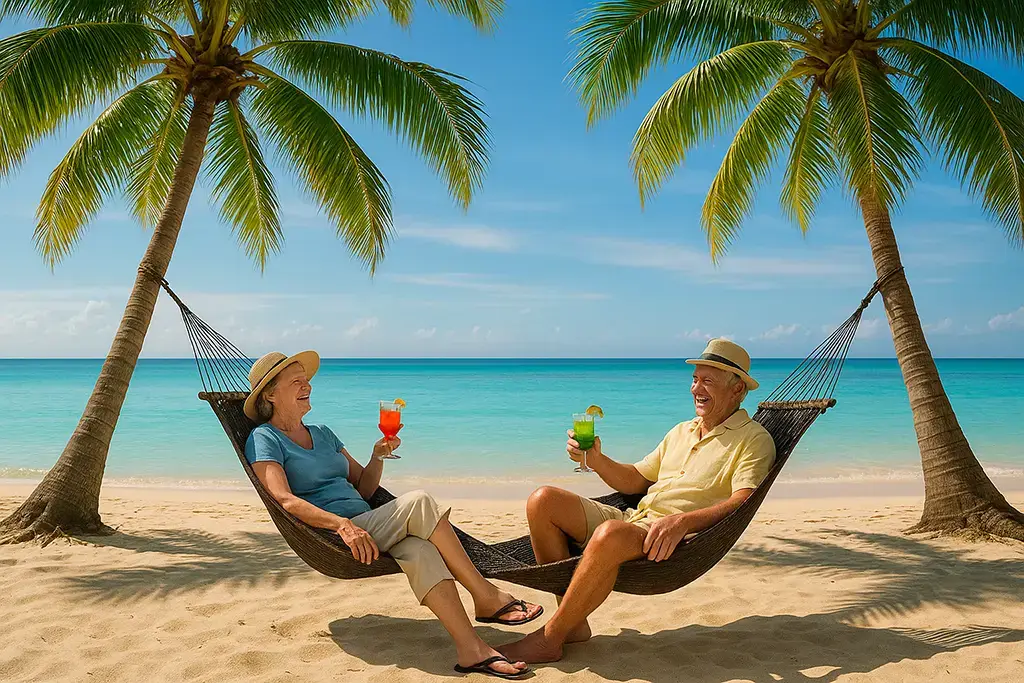
Retire in the Philippines: The Ultimate Escape Plan
Let’s not sugarcoat it—retirement isn’t about quietly fading into khaki shorts and oatmeal. It’s about living. And if you’re looking for the best place to retire with warm weather, low costs, and people who smile at strangers, then retiring in the Philippines is about to rocket to the top of your bucket list.
So why are retirees ditching overpriced condos in Florida and running barefoot into the sandy arms of the Philippines expat community?
Because this country is a charming mix of affordability, beauty, and tropical weirdness, let’s break it all down.
When it comes to choosing a retirement destination, most people envision a peaceful, sunny place that blends comfort, affordability, and beauty. For many retirees, the Philippines has become their dream come true. With its pristine beaches, low cost of living, friendly locals, and English-speaking population, it’s no wonder this Southeast Asian paradise consistently ranks among the top global retirement spots.
However, the appeal of the Philippines extends far beyond its tropical vibes and breathtaking views. It offers an excellent quality of life at a fraction of the cost found in Western countries, access to affordable healthcare, and a community that warmly welcomes foreign retirees. Whether you’re seeking vibrant city life, serene beachfront living, or a fabulous mountain retreat, the Philippines has something for everyone. Let’s dive into what makes the archipelago a retirement haven worth exploring.
Affordable Cost of Living in the Philippines for Retirees

One word: cheap. Okay, another word: awesome.
- Rent: $300–$500/month scores you a beach-adjacent, fully-furnished apartment with Wi-Fi and probably a stray cat that adopts you.
- Groceries: Buy tropical fruits, fresh fish, rice, and eggs for the cost of a Netflix subscription.
- Utilities: Water + electric? About $100/month. A/C guilt is extra.
- Dining out: Fancy meal for two? $10–$15. Street food fiesta? Under $5.
- House help: You can hire a friendly human to do your laundry, cook, and smile at you for about $150/month.
You can live on Social Security in the Philippines—and live well—without resorting to ramen noodle diets.
Retiring in the Philippines comes with one significant advantage: your money goes a long way. Whether you’re living on a pension, Social Security, or savings, the Philippines allows you to enjoy a high quality of life without depleting your budget.
Let’s start with housing. Rent varies depending on location, but even in Metro Manila, you can find a furnished one-bedroom apartment in a good area for around $300 to $500 per month. In smaller cities like Dumaguete or Baguio, this can drop to as low as $150 per month. Utilities, including electricity, water, and internet, typically cost less than $100 per month.
Grocery shopping, transportation, and eating out are similarly affordable. A meal at a mid-range restaurant typically costs between $5 and $10, while local eateries offer delicious Filipino meals for as little as $2. Jeepneys, buses, and taxis make getting around inexpensive and easy, with rides costing less than a dollar.
If you love local markets, you’re in for a treat—fresh fruits, vegetables, seafood, and meats are abundant and incredibly affordable. Health insurance and private healthcare are also reasonably priced, with monthly premiums starting at just $30 for basic plans. Overall, many expats report living comfortably on $1,200 to $1,500 per month, including rent, food, transportation, and leisure. This makes the Philippines one of the most cost-effective retirement destinations in the world.
Best Places to Retire in the Philippines
One of the best aspects of the Philippines is its geographic diversity, with over 7,000 islands to choose from. Retirees can select from a wide range of locations, each offering a unique lifestyle and environment.
Metro Manila: For City-Slicker Retirees
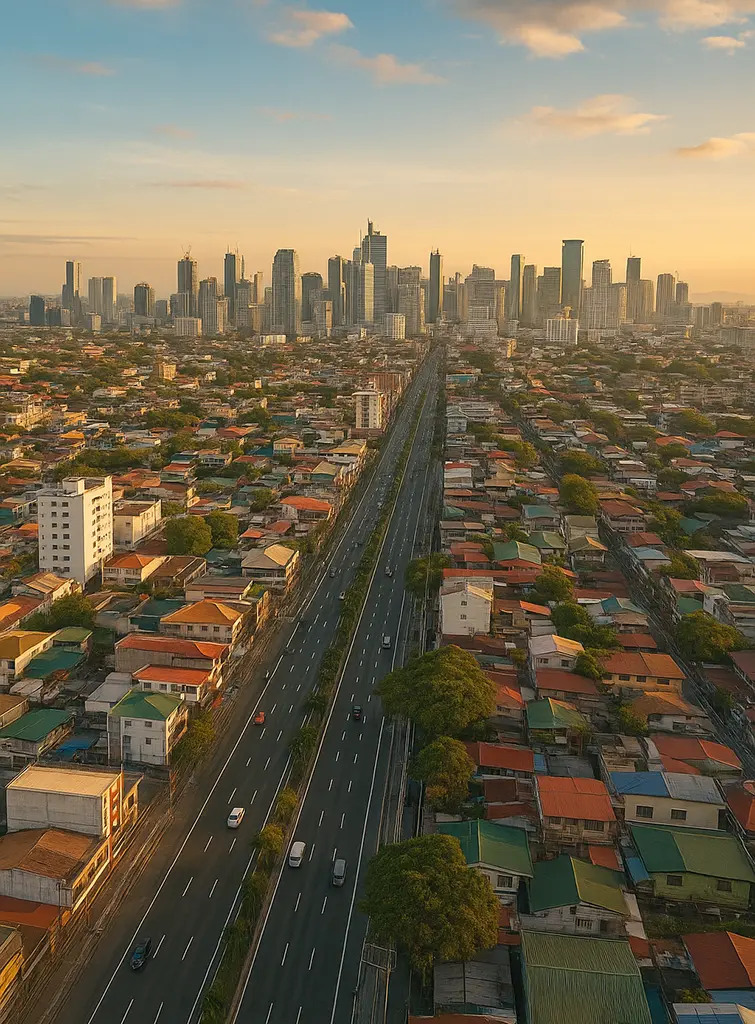
Big, loud, chaotic—Metro Manila is not for the faint of heart. But if you want top-notch hospitals, expat clubs, and enough shopping malls to make Amazon nervous, this urban jungle delivers.
Pros:
- Premier Philippines healthcare for expats
- International connections
- Endless dining, entertainment, and… traffic
For those who enjoy the buzz of city life, Metro Manila offers all the urban amenities you could ask for. This metropolitan area comprises a network of cities, including Makati, Taguig, and Quezon City, which provide luxury condos, shopping malls, restaurants, international schools, and world-class hospitals.
While it’s more expensive than rural areas, retirees enjoy the convenience, entertainment, and access to international flights. The city is also home to several expat communities and embassies.
Cebu: Retirement Sweet Spot
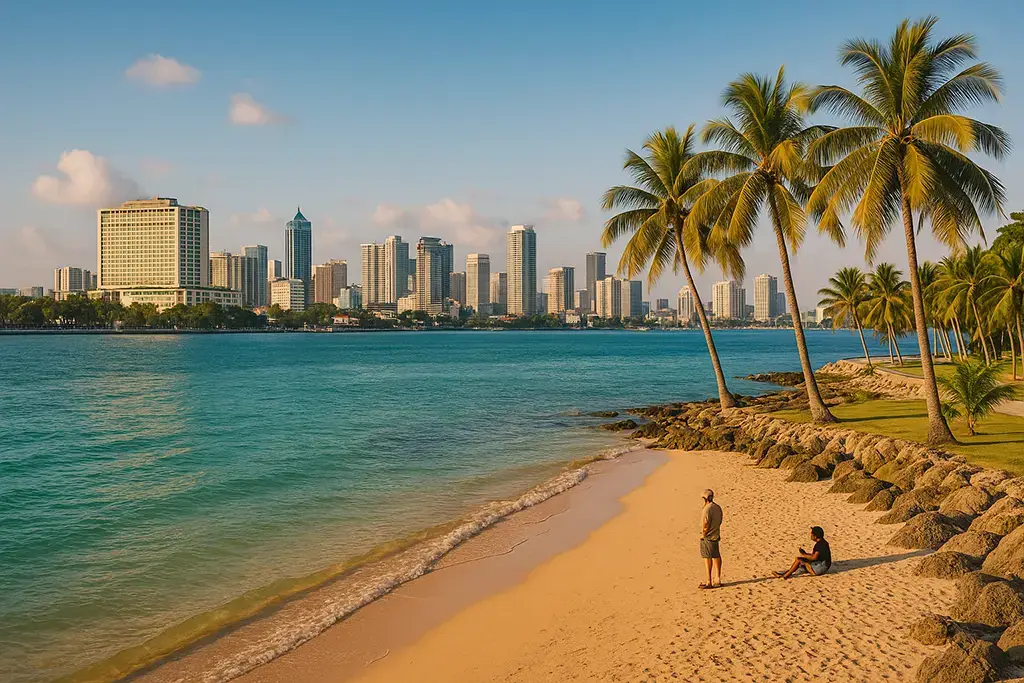
Retire in Cebu, Philippines, if you want beaches and modern comforts without full-on urban overload.
- Large expat community
- Great hospitals
- Stunning beaches, waterfalls, and pork that will ruin all other pork for you
Cebu is often referred to as the “Queen City of the South.” It offers the perfect blend of city conveniences and island relaxation. Cebu City boasts excellent healthcare, shopping centers, and nightlife. Just a short drive or ferry ride away, you can find idyllic beaches and a peaceful countryside.
It’s a significant hub for expats, boasting a high concentration of English speakers, excellent infrastructure, and convenient transportation. Living costs are lower than in Manila, and real estate options range from high-rise condos to seaside villas.
Dumaguete – The “City of Gentle People”: Gentle and Budget-Friendly
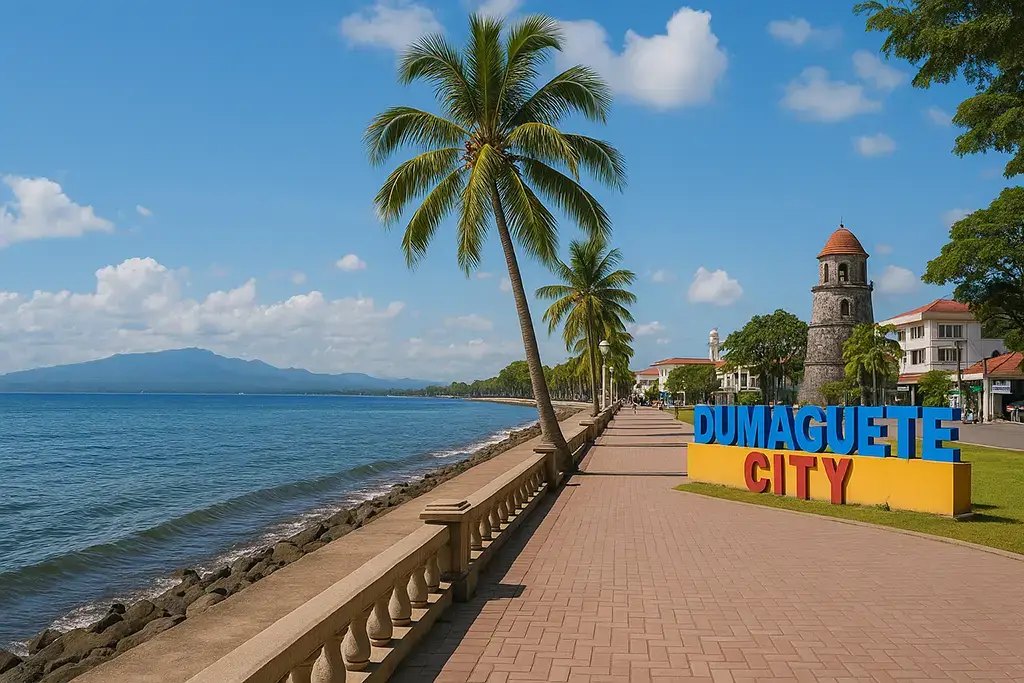
Ask around about Dumaguete retirement communities and watch fellow expats nod approvingly.
- Super walkable
- Cost of living: dirt cheap
- Locals speak English better than your cousin Larry
- Home of the famous “City of Gentle People” vibe
This charming coastal town is rapidly becoming a retirement hotspot, known for its laid-back lifestyle and friendly residents. Dumaguete offers a slower pace of life that is perfect for retirees.
It’s affordable, safe, and surrounded by natural beauty—from diving spots to scenic mountain trails. Dumaguete also boasts a vibrant expat community and is home to several universities, lending it a youthful and culturally vibrant atmosphere.
Baguio: For the Heat-Resistant
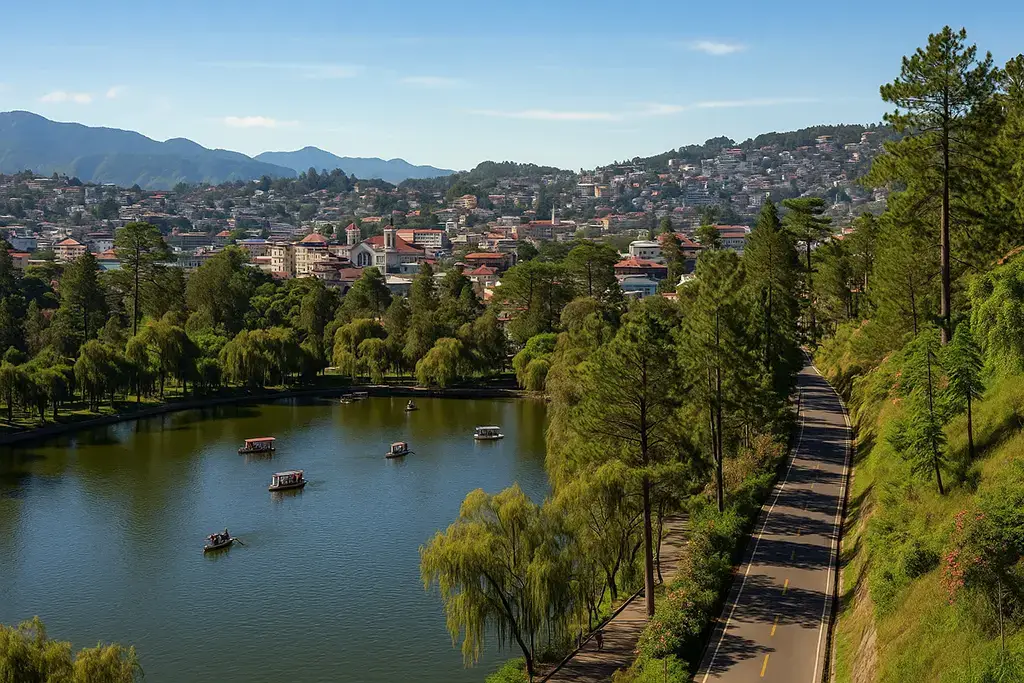
High up in the mountains, living in Baguio as a foreigner means cool breezes, pine trees, and a need for sweaters. Yes, sweaters in the Philippines.
- Artsy scene
- Organic markets
- Less sweat
If you prefer cooler temperatures, Baguio is the go-to destination. Located in the Cordillera mountains, it offers a pine-scented, highland climate with temperatures averaging 15–23°C (59–73°F). Retirees love Baguio for its scenic views, fresh produce, and rich cultural heritage.
Baguio’s colonial architecture, local art scene, and temperate climate make it a unique destination. Additionally, real estate in this area remains affordable compared to other major cities.
Tagaytay: Scenic, Calm, and Close to Manila
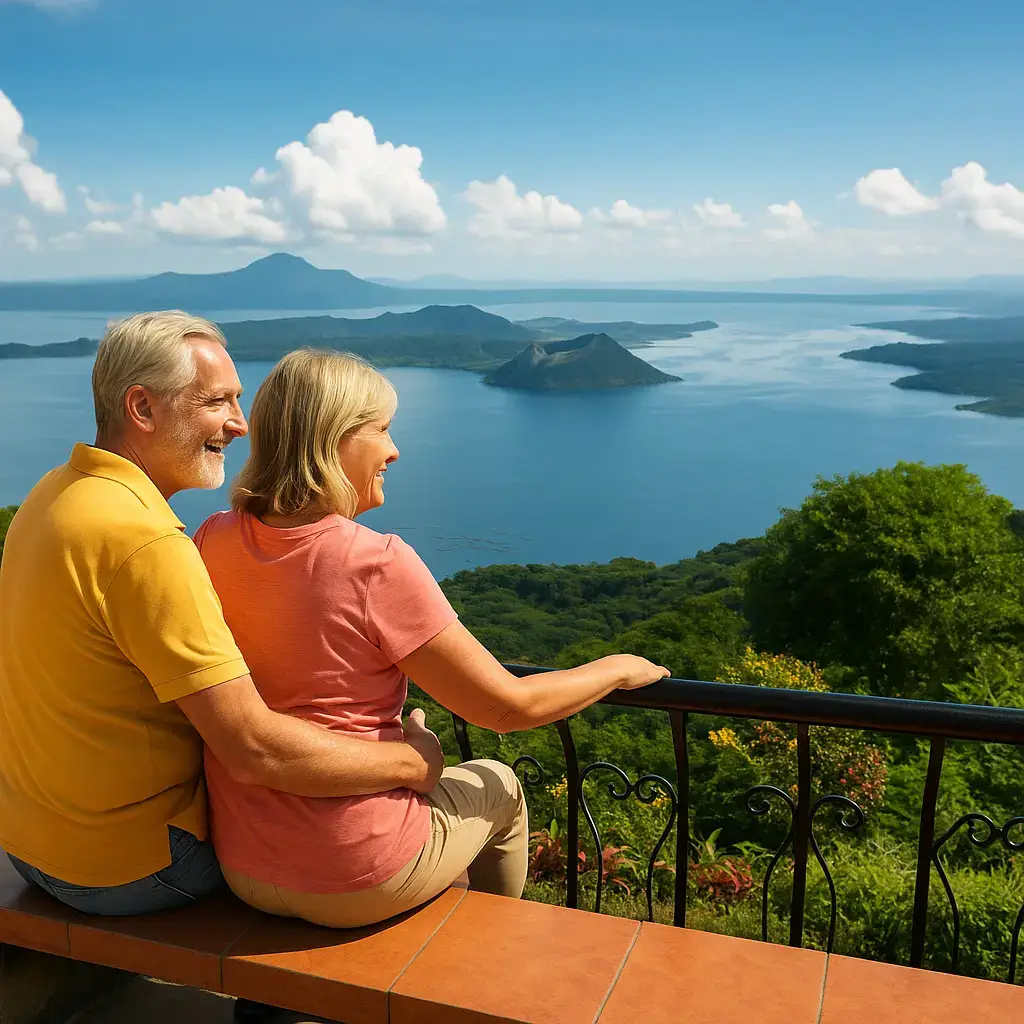
If you’re looking for cooler weather, great food, and a stunning volcano view, Tagaytay retirement homes are calling your name.
- Weekend getaway charm
- Cozy hillside homes
- Volcano tourism without the lava risk
Just two hours south of Manila, Tagaytay offers stunning views of Taal Volcano and Lake. The cooler climate, fresh air, and relaxed lifestyle attract retirees who want to be close to Manila without the hustle and bustle.
Tagaytay has everything you need—restaurants, supermarkets, medical clinics, and gated communities—wrapped in a countryside ambiance. It’s ideal for weekend getaways or full-time retirement.
The Philippines Retirement Lifestyle: Daily Bliss
Imagine this:
- Morning mango and coffee with an ocean breeze
- Afternoon nap (yes, please)
- Dinner with expat friends by the water
- Karaoke battles with neighbors who sing like it’s their side hustle
This is everyday life. The retirement lifestyle in the Philippines isn’t a fantasy—it’s Tuesday.
Why Retire in the Philippines? Let’s Talk Features
1. Warm Weather
Bring sunscreen and a hat. The sun doesn’t quit.
2. Gorgeous Nature
From underground rivers to volcanoes and coral reefs, retirees living abroad rarely get this kind of variety.
3. English is Widely Spoken
No need to master Tagalog. Most people speak English and want to chat.
4. Senior-Friendly Culture
Here, being older means you get respect, priority lines, and frequent compliments. You’ll feel like royalty with wrinkles.
Notable Features of the Philippines
The Philippines isn’t just a tropical getaway—it’s a way of life. One of the most appealing aspects for retirees is the nation’s unique blend of natural charm, cultural warmth, and everyday convenience. Let’s break down what makes this country shine beyond its palm-fringed beaches.
Firstly, the climate. The Philippines enjoys a tropical climate with sunshine almost year-round. Although it has a rainy season, most areas receive plenty of sunny days, perfect for beach outings, gardening, or simply relaxing outdoors. For those who prefer milder weather, higher-elevation cities like Baguio and Tagaytay offer cooler temperatures.
Another undeniable plus is the country’s natural beauty, featuring crystal-clear waters, coral reefs, lush jungles, rice terraces, volcanoes, and serene beaches. From Palawan’s pristine islands to Bohol’s Chocolate Hills, the country seems to have been crafted for postcard perfection. These wonders offer retirees an endless array of nature escapes and photography opportunities.
What’s equally notable is the language advantage. English is one of the country’s official languages and is widely spoken, making communication easy for most foreign retirees. Road signs, government documents, menus, and even TV shows are available in English. This eliminates language barriers and significantly eases daily life.
Then there’s the hospitality. Filipinos are known for being incredibly friendly, helpful, and welcoming. Many retirees comment on how quickly they feel at home, thanks to the strong sense of community and inclusiveness. It’s easy to make friends, whether among locals or within the robust expat circles spread across the islands.
Combine these features with low costs, modern conveniences, and vibrant cultural traditions, and it’s easy to see why the Philippines has a charm that’s hard to match. Whether you’re an adventurer, a beach bum, or someone seeking a peaceful retreat, there’s a special spot waiting for you.
Philippines Healthcare for Expats

Yes, healthcare in the Philippines is legit—and cheap.
- Doctor visit: $15–$30
- Dental cleaning: Around $20
- Prescriptions: Often 50%+ less than Western prices
- Private hospitals: Excellent in major cities like Manila, Cebu, and Davao
You can enroll in PhilHealth for foreigners or opt for private insurance. Either way, your wallet won’t scream.
Quality and Availability of Healthcare
Healthcare is one of the top concerns for anyone planning retirement abroad. The good news is that the Philippines delivers quality healthcare services at a fraction of the cost found in Western countries. From private hospitals in major cities to local clinics in rural areas, retirees have access to a broad range of medical care.
Let’s start with availability. In major urban centers like Manila, Cebu, and Davao, you’ll find hospitals that are internationally accredited and staffed with English-speaking medical professionals. Big names include St. Luke’s Medical Center, Makati Medical Center, and The Medical City. These facilities provide top-tier services in cardiology, surgery, oncology, and other specialties. Even in smaller cities like Dumaguete or Iloilo, well-equipped hospitals and clinics provide reliable care.
Next is affordability. Even without insurance, most healthcare services are reasonably priced. A typical doctor’s consultation costs between $10 and $30. Laboratory tests, dental care, and minor surgeries are significantly cheaper than in the US or Europe. For example, an MRI scan in the Philippines can cost around $250–$300, compared to thousands of dollars in the US or Europe.
Many retirees opt for local or international health insurance plans specifically designed for expatriates. Providers like PhilHealth (the government-run health insurance) offer basic coverage for a very low premium, while private insurance covers broader treatments and emergencies.
Then there’s the added convenience of expat-focused clinics. In popular retirement areas, you’ll find medical centers that cater specifically to foreign nationals. These clinics often provide faster service, English-speaking staff, and patient-centered care. In essence, healthcare in the Philippines is both accessible and cost-effective, ensuring peace of mind during your golden years.
Safety for Retirees in the Philippines
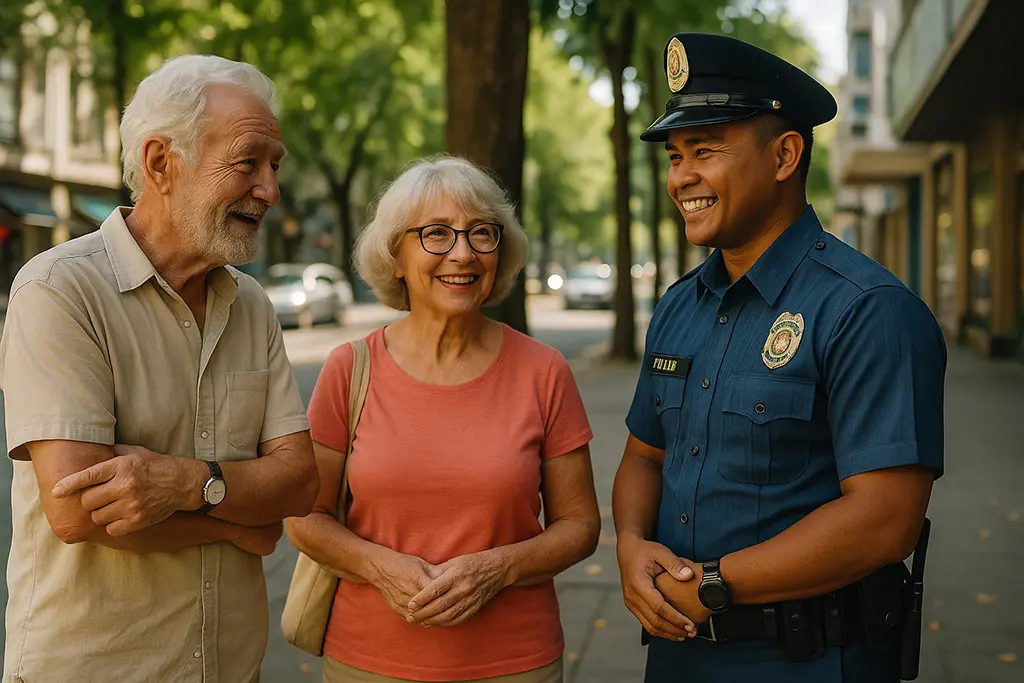
Let’s not sugarcoat: No place is perfect. But how safe is the Philippines for retirees?
Answer: Generally very safe, especially in expat-friendly towns.
- Violent crime is low
- Petty theft happens (like everywhere)
- Gated communities, guards, and watchful neighbors are common
Use common sense. Avoid shady bars and refrain from wearing flashy gold watches. Boom—safe.
Safety and Security for Expats
Safety is a priority for retirees, and rightly so. The idea of settling in a new country brings up questions about personal security, healthcare accessibility, and overall quality of life. Fortunately, the Philippines ranks well in these areas, particularly in the provinces and cities that are favored by retirees.
Let’s address the crime rate. While urban centers like Manila may experience typical city-related petty crimes (like pickpocketing), most retirement destinations such as Dumaguete, Tagaytay, Baguio, and Iloilo enjoy a reputation for being peaceful and secure. Violent crime is rare in these regions, and most communities are close-knit and well-patrolled.
Local authorities and barangay officials (village-level leaders) play an active role in ensuring community safety. Many subdivisions and condo developments have 24/7 security personnel, gated entries, and CCTV systems in place, offering an added layer of comfort for residents.
Then there’s the strong expat network. Many retirees form tight-knit communities where members look out for one another, share safety tips, and provide updates on local developments. These communities often collaborate with local police and security personnel to maintain peace and order.
The Filipino people also add to the overall sense of safety. The culture is deeply rooted in respect, family values, and a tradition of hospitality. Foreigners are typically treated with friendliness and warmth, and it’s not uncommon for neighbors to go out of their way to help a newcomer settle in. Yes, the Philippines is a safe place to retire—as long as you follow common-sense practices, avoid isolated areas at night, and stay informed about your surroundings. Just like anywhere else, being aware and cautious pays off.
How to Get Residency in the Philippines

There’s an easy path, and it’s called the SRRV visa (Special Resident Retiree’s Visa). AKA the golden ticket.
SRRV Benefits:
- Indefinite stay
- Multiple entry
- Access to the Philippines’ retirement visa perks
- No exit clearance nonsense
SRRV Requirements:
- A deposit of $10,000–$50,000 (depends on your pension and age)
- Health check
- Police clearance
- Some paperwork and a pulse
Visa and Residency Options for Retirees
The Philippines offers one of the most attractive and flexible visa options for retirees in Asia—the Special Resident Retiree’s Visa (SRRV). This long-term visa enables foreigners to reside in the country indefinitely, offering multiple-entry privileges, tax incentives, and other retirement-friendly benefits.
Let’s examine the SRRV program in more detail. It’s managed by the Philippine Retirement Authority (PRA) and comes in several categories, each designed to suit different retiree profiles. The most popular one, SRRV Classic, requires a time deposit of $10,000 to $50,000, depending on the applicant’s age and pension status.
One huge perk of this visa is that it eliminates the need to exit and re-enter the country every few months. SRRV holders also enjoy:
- Exemption from customs duties and taxes for one-time importation of household goods (up to $7,000)
- Access to the Philippine healthcare system
- Tax-free pensions and annuities remitted from abroad
- Assistance from PRA officers in dealing with local agencies
Applying for the SRRV is pretty straightforward, but it involves submitting documents such as a medical clearance, police certificate, proof of pension or income, and completing a visa application form. The process typically takes between a few weeks and a few months, depending on the processing time.
Retirees who prefer short stays or want to test the waters can enter the Philippines on a tourist visa, which is initially valid for 30 days and can be extended up to 36 months. Whether you’re planning a trial run or ready to make the Philippines your permanent home, the visa options are retirement-friendly, flexible, and relatively easy to manage.
Services, Infrastructure, and Connectivity

Even paradise has to be practical.
- Internet: Fiber-optic is common in cities; yes, you can stream Netflix and do Zoom karaoke.
- Transportation: Grab (the local Uber), jeepneys, ferries, buses, and tricycles. Alternatively, you can buy a scooter and ride like royalty.
- Banking: Opening accounts is easy (provided you have patience). Wire transfers? Check.
- Shopping: Malls here are absurdly large, offering everything from groceries to massage, dental services, cinema, and Korean BBQ—all in one stop.
Availability of Services and Amenities
One of the biggest concerns for retirees moving abroad is whether they’ll have access to the same conveniences they enjoyed back home. Thankfully, the Philippines doesn’t disappoint. From high-speed internet to massive shopping malls and international cuisine, the infrastructure and services in most areas are well-developed.
Let’s start with housing options. Whether you prefer a beachfront bungalow, a high-rise condo, or a quiet suburban home, the choices are plentiful. Most expats opt for modern condos or houses in gated communities that offer amenities such as swimming pools, gyms, and clubhouses.
Next, we’ve shopping and dining. Cities like Manila, Cebu, and Davao boast massive malls, such as SM Mall of Asia, Ayala Center, and Robinsons. These malls are more than just shopping centers—they’re lifestyle hubs with cinemas, spas, medical clinics, banks, and restaurants offering a wide range of options, from Japanese sushi to American burgers.
Technology and connectivity are top-tier in many parts of the country. Fiber-optic internet, mobile data plans, and cable TV are widely available and reasonably priced. Streaming services like Netflix and YouTube are popular, and most homes are connected to the internet.
Essential services, including banking, public transport, and utilities, are efficient and improving steadily. Most banks offer services in English, and online banking apps are widely used. Local and international courier services, such as DHL, LBC, and GrabExpress, make logistics hassle-free. Ride-sharing apps like Grab have also made transportation more convenient than ever.
In short, you don’t have to give up comfort and convenience when you retire in the Philippines. Everything you need—from healthcare to your favorite latte—is within reach.
Strong Expat Community and Social Life

One of the most comforting aspects of retiring in the Philippines is the ease of building a social life. With its warm-hearted locals and a thriving expat population, you’re never truly alone. Whether you’re looking to make new friends, join social groups, or find someone to share stories with, you’ll find that sense of belonging here.
Expat communities are well-established in many parts of the country. Cities like Dumaguete, Cebu, Subic, and Tagaytay have sizeable populations of foreign retirees—Americans, Europeans, Australians, and Asians alike. These communities organize regular meetups, potlucks, sports tournaments, cultural events, and charity work. You can join Facebook groups or local expat clubs to instantly connect and get insider tips about life in your area.
Social opportunities are abundant. Want to play golf? Many subdivisions and cities have private and public golf courses. Prefer something laid-back? Join a local chess club or attend a Sunday art fair. Beaches host yoga sessions, and resorts offer dance nights, karaoke, and live music.
What’s more, locals are incredibly approachable and friendly. Don’t be surprised if your neighbor invites you over for a meal or offers to show you around the town. Filipinos love conversation, music, and celebration, and their openness often breaks the cultural ice quickly.
Cultural integration is also encouraged. Many expats volunteer in schools, churches, and environmental programs. Teaching English, supporting local businesses, or mentoring youth can give you a rewarding sense of purpose.
Retiring in the Philippines doesn’t mean retreating from the world—it means stepping into a vibrant, welcoming lifestyle where meaningful social connections are just around the corner.
Ease of Travel Within and Outside the Country
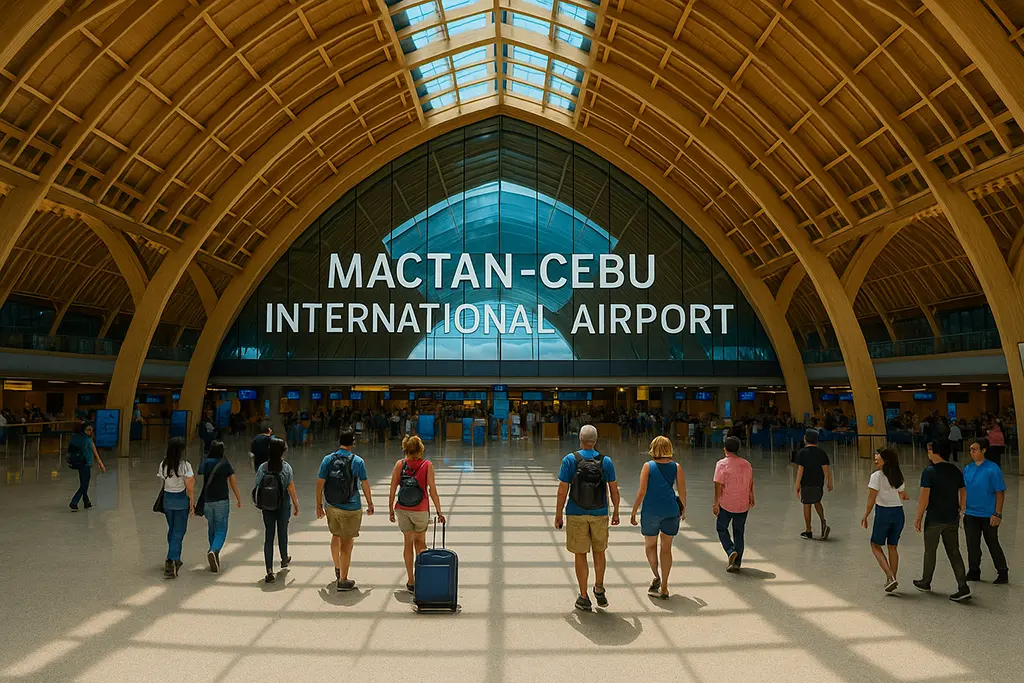
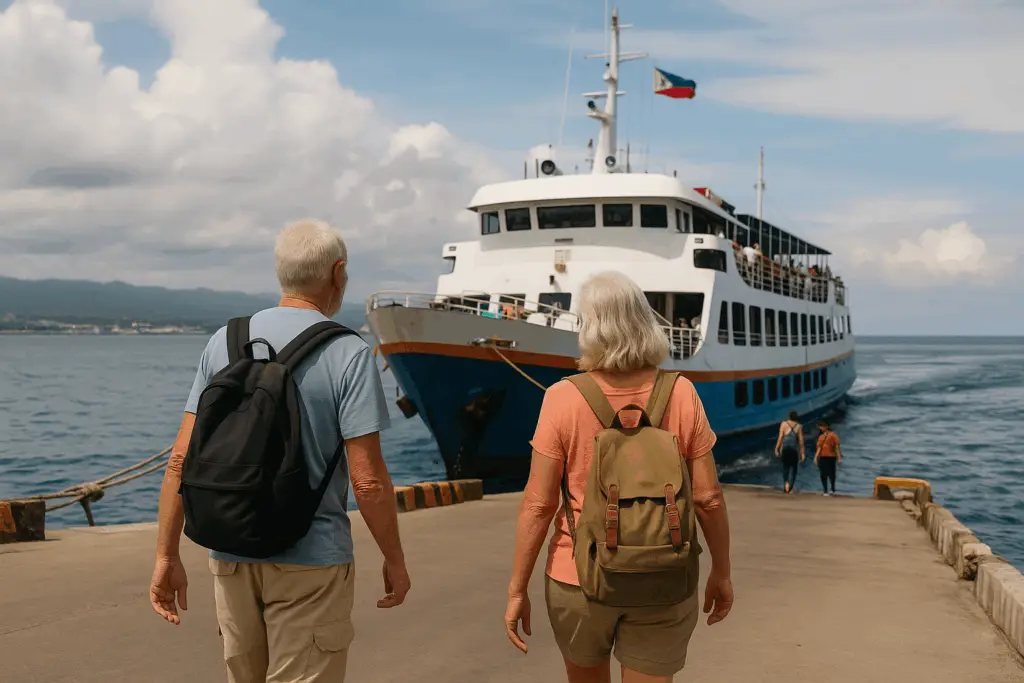
If you’re someone who enjoys exploration and spontaneity, the Philippines is a dream come true. The country’s extensive transport network—by air, sea, and land—makes both domestic and international travel incredibly convenient.
Let’s start with domestic travel. The Philippines has dozens of airports, with major international gateways in Manila, Cebu, Clark, and Davao. From there, you can take a quick flight to idyllic islands like Palawan, Bohol, or Siargao. Most inter-island flights are under an hour and cost less than $100 round-trip.
For short trips, ferries and buses offer scenic alternatives. Popular routes connect major islands and coastal towns, allowing you to enjoy lush mountains, tropical beaches, and quaint villages—all without the need to fly.
Now, for retirees who like to explore outside the Philippines, you’re well-positioned. Manila and Cebu are hubs for budget airlines like Cebu Pacific and AirAsia, offering direct flights to nearby countries such as Thailand, Vietnam, Malaysia, Japan, and South Korea. If you want to visit family back home, long-haul flights to the U.S., Australia, or Europe are frequent and relatively affordable when booked in advance.
Transportation within cities is also improving. Ride-hailing apps like Grab work similarly to Uber and are widely available in most urban areas. Tricycles, jeepneys, and buses are fun local options, although retirees often opt for taxis or hire personal drivers for added comfort.
Retiring in the Philippines doesn’t mean staying in one spot—it means opening a new chapter filled with adventures, near and far.
Cultural Attractions and Recreational Activities
Life in the Philippines isn’t just about sunbathing and sipping fresh mango juice—there’s a rich cultural scene and a long list of things to do. From fiestas and music festivals to hiking volcanic trails or diving with sea turtles, there’s no shortage of ways to fill your days.
Cultural attractions are abundant. Historical sites, such as Intramuros in Manila and the Spanish churches in Iloilo, offer glimpses into the country’s colonial past. Museums, local art galleries, and traditional markets are scattered across major cities and towns. Every province has its festival—Sinulog in Cebu, Ati-Atihan in Kalibo, and Panagbenga in Baguio are just a few of the colorful, music-filled events that enliven the calendar.
If you’re more into the outdoors, you’ll never run out of adventures. The Philippines is a haven for snorkelers, scuba divers, surfers, hikers, and island-hoppers. Imagine diving in the world-famous Tubbataha Reefs, surfing the waves of Siargao, or trekking to the crater of Mount Pinatubo.
For those who prefer a relaxed approach to recreation, there are resort stays, boat tours, fishing trips, golf courses, and spas to indulge in. You’ll find leisure clubs, art classes, culinary workshops, and gardening groups—all perfect ways to enjoy your retirement with a touch of creativity and community engagement.
Many retirees also find joy in giving back. Volunteer opportunities in teaching, community outreach, and environmental efforts are everywhere and incredibly fulfilling.
Whether you’re a history buff, a nature lover, or someone seeking connection, the Philippines offers a lifestyle as active or relaxed as you desire.
Real Estate Opportunities
Considering a permanent move? The Philippines offers a diverse range of real estate options to suit every style and budget. From beachfront bungalows to modern city condos, owning or leasing property here is a very achievable goal, once you understand the local system.
Let’s clear up a common question: Can foreigners own land? No, foreigners cannot own land directly, but they can legally own condominiums (up to 40% of a building’s total unit ownership). You can also lease land for a long term (up to 50 years with a possible 25-year extension), or co-own property with a Filipino spouse or through a corporation.
Popular property types include:
- Condos in Manila, Cebu, and Davao with pools, gyms, and security
- House-and-lot packages in gated communities
- Beachfront cottages in places like Palawan and Siquijor
- Farm lots or countryside villas in places like Cavite or Bukidnon
Prices vary widely. A one-bedroom condo in a city center might cost $50,000–$80,000, while a beachfront home in a provincial area can be under $100,000. Rental returns are also possible if you plan to sublet during travels.
To navigate this process, it’s best to hire a local real estate lawyer or use a trusted broker. Ensure that proper documentation, titles, and due diligence checks are completed. Additionally, there are real estate expos and online platforms dedicated to helping expats buy property.
Whether you’re buying or leasing, real estate in the Philippines offers excellent value and an opportunity to build a beautiful home base for your retirement.
The Filipino Way of Life
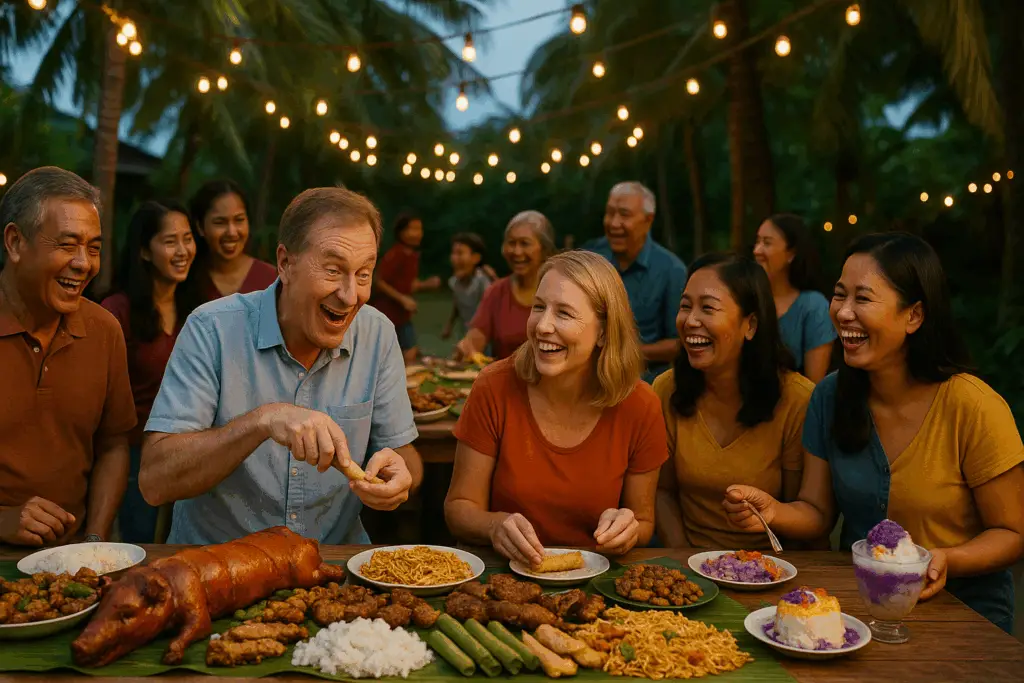
Retiring in the Philippines means more than just a change in scenery—it means embracing a whole new rhythm of life. One that’s relaxed, family-oriented, and deeply rooted in joy.
Filipinos have a unique outlook on life, characterized by resilience, cheerfulness, and a strong sense of community. You’ll hear laughter on the streets, see neighbors helping one another, and feel the warmth that makes living here so special.
At the heart of the Filipino way of life is family and togetherness. Retirees often find themselves “adopted” into their community—invited to birthday celebrations, fiestas, or casual Sunday lunches. This culture of inclusion makes it easy to feel at home.
Another standout feature is the slower pace. If you’re coming from a high-pressure lifestyle, you’ll appreciate the calmness here. Time feels abundant, with less rush, fewer honking cars, and more opportunities to pause and enjoy the moment. Whether you’re sipping local coffee on your porch or chatting with your sari-sari store vendor, life here feels… lighter.
Additionally, spirituality and gratitude are deeply embedded in everyday living. Most Filipinos are deeply religious, often attributing life’s joys to divine blessings. This sense of faith, combined with an optimistic attitude, creates an atmosphere that nurtures both mental and emotional well-being.
Retiring in the Philippines is not just about where you live—it’s about how you live. And here, life is full of small joys, big hearts, and genuine smiles.
Downsides to Retiring in the Philippines
Let’s keep it real.
- Humidity: Your hair will revolt.
- Traffic: Especially in cities. Learn patience—or invest in podcasts.
- Bureaucracy: Paperwork can feel like an Olympic event. Bring snacks.
- Internet hiccups: Rainstorms = router drama
- Typhoons: Nature’s way of saying “don’t get cocky”
Still, none of these outweighs the upside.
If you’re not yet familiar with the Philippines, I would encourage you to take some time to visit. Check out the areas that interest you and stay for a month or two, then decide what you want to do.
Ready to Retire in the Philippines?

If retirement is a new chapter of freedom, relaxation, and discovery, then the Philippines is the perfect setting to write that story. With its warm climate, breathtaking natural beauty, and incredibly welcoming culture, this island nation offers more than just a place to live; it offers a lifestyle rich in meaning, peace, and adventure.
From vibrant cities like Manila and Cebu to tranquil retreats such as Dumaguete and Tagaytay, retirees have numerous options when it comes to finding their ideal home. You’ll enjoy an affordable cost of living that stretches your budget without compromising comfort or convenience. Access to high-quality healthcare, diverse real estate options, modern amenities, and strong expat communities make the transition easy and enjoyable.
What truly sets the Philippines apart, however, is its soul—the spirit of the people, the warmth of every interaction, and the slower, joyful rhythm of daily life. Here, you’re not just a retiree—you’re part of a community that values kindness, family, and connection. So, if you’ve been dreaming of a retirement filled with stunning sunsets, simple pleasures, and heartfelt smiles, it might be time to take a closer look at the Philippines. Because sometimes, paradise isn’t just a place on a map—it’s where you feel most at peace.
You’ve worked hard. You deserve palm trees, smiles, and a fresh coconut in your hand. The retirement lifestyle in the Philippines is not just affordable—it’s delightful.
So, ask yourself:
Why shovel snow when you could sip rum by the sea?
Time to turn that dream into a plane ticket.
Frequently Asked Questions (FAQs)
1. Can Americans retire in the Philippines?
Yes, and they do in droves. You’ll fit right in—bonus points if you like karaoke.
2. How much does it cost to live in the Philippines?
A comfortable lifestyle can cost $1,200–$1,800/month. Frugal folks can do it for less.
3. Is healthcare good and affordable?
Yes and yes. Private hospitals offer excellent care at a fraction of U.S. costs.
4. Do I need to learn Tagalog?
Nope. English is widely spoken, especially in retirement hubs.
5. Can I own property in the Philippines?
Condos? Yes. Land? Not directly—unless you marry a local or set up a corporation.
6. What’s the SRRV visa all about?
It’s a long-term Philippine retirement visa that offers perks and peace of mind.
7. What are the best retirement towns in the Philippines?
Cebu, Dumaguete, Tagaytay, Baguio, and parts of Metro Manila top the list.
8. Is it safe to retire in the Philippines?
Yes. Use common sense and don’t act like a tourist in an action movie.
9. What’s expat life like?
Friendly, fun, and full of social events. The Philippines expat community is thriving.
10. Will I get bored?
Only if you avoid beaches, karaoke, festivals, hiking, volunteering, and mangoes.
Other Articles that may be of Interest
You may also find the following articles interesting.
- Why Expats Love (and Occasionally Panic in) the Philippines
- Diving into the Blue – A Spotlight on the Best Dive Sites in Bohol
Suggestions For Lodging and Travel
Lodging is widely available throughout the Philippines. However, you may want to consider getting assistance booking tours to some of the Philippines’ attractions. I’ve provided a few local agencies that we’ve found to be very good for setting up tours. For transparency, we may earn a commission when you click on certain links in this article, but this doesn’t influence our editorial standards. We only recommend services that we genuinely believe will enhance your travel experiences. This will not cost you anything, and I can continue to support this site through these links.
Local Lodging Assistance
- Guide to the Philippines: This site specializes in tours throughout the Philippines, offering flexibility in scheduling and competitive pricing. I highly recommend them for booking local arrangements for a trip like this one. You can book flights and hotels through the Expedia link provided below.
- Hotel Accommodations: I highly recommend The Manila Hotel for a stay in Manila. I stay here every time I travel to the Philippines. It is centrally located, and many attractions are easily accessible from there. Intramuros and Rizal Park are within walking distance. I have provided a search box below for you to use to search for hotels (click on “Stays” at the top) or flights (click on “Flights” at the top). This tool will provide me with an affiliate commission (at no additional cost to you).
- Kapwa Travel is a travel company focused on the Philippines. It specializes in customizing trips to meet customers’ needs.
- Tourismo Filipino is a well-established company that has been operating for over 40 years. It specializes in tailoring tours to meet customers’ needs.
- Tropical Experience Travel Services – Tours of the Philippines: This company offers a range of tour packages, allowing you to tailor your trip to your preferences.
Lastly, we recommend booking international travel flights through established organizations rather than a local travel agent in the Philippines. I recommend Expedia.com (see the box below), the site I use to book my international travel. I have provided a search box below for you to use to search for flights (click on “Flights” at the top) or Hotels (click on “Stays” at the top). This tool will provide me with an affiliate commission (at no cost to you).